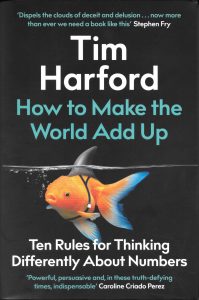The one sentence summary
With the right approach it is possible to evaluate confidently the claims that surround us.
Can’t be bothered to read it? Too much screen time lately? Listen to the 5-minute podcast.
WHAT THE BOOK SAYS 
- The book contains ten rules for thinking differently about numbers, plus one golden rule. They are:
- Search your feelings: how does this make me feel, and why? Check your emotional reaction.
- Ponder your personal experience: take the worm’s eye view (personal) as well as the bird’s eye view (statistical).
- Avoid premature enumeration: don’t take numbers at face value – establish what is really being counted.
- Step back and enjoy the view: ask yourself: is that a big number? Put the claim into context and look for comparisons.
- Get the back story: look behind the statistics to find out where they came from.
- Ask who is missing: not all data is comprehensive. Would our view be different if we knew more?
- Demand transparency when the computer says no: what algorithm was used and how accurate and helpful is it? Without intelligent openness big datasets cannot be trusted.
- Don’t take statistical bedrock for granted: most official statistics can be trusted, but many others can’t.
- Remember that misinformation can be beautiful too: beware misleading graphs and charts – they can be designed to prove pretty much anything, so check that you understand what the axes actually mean. The smarter they are, the more suspicious you should be.
- Keep an open mind: how might I be mistaken, and have the facts changes since?
+. The golden rule. Be curious: look deeper and ask questions.
WHAT’S GOOD ABOUT IT
- Good statistics are not a trick and they have the power to change the world for the better. But bad research and misplaced motivation can take us deep into a world of disinformation and obfuscation.
- Motivated reasoning is when someone’s judgement is strongly influenced by what they hope will be true.
- Some studies are subject to HARKing – Hypothesising After Results Known. A lot of contrary findings are never even published.
- A statistical metric may be a decent proxy for something that matters, but once you use that as a target to be improved, it will be distorted, faked or undermined.
- Keynes is reported to have said: “When my information changes, I alter my conclusions. What do you do, sir?” There’s no firm evidence that he did, but the quote is useful for being prepared to change your views.
- Statistics in themselves don’t deliver benefits, but the use of statistics can.
- Actively open-minded thinkers make the best forecasters because they don’t cling too tightly to a single approach.
- The illusion of explanatory depth is a curiosity killer and a trap – if we think we already understand, why go deeper?
WHAT YOU HAVE TO WATCH
- Nothing. This is well-argued and should be helpful to all.
